Asphodelaceae
Aloidendron barberae (Dyer) Klopper & Gideon F.Sm.
Family:
Common names: tree aloe (Eng.); boomaalwyn, mikaalwyn (Afr.); ikhala (Xhosa); umgxwala, indlabendlazi, impondonndo, inkalane-enkulu (Zulu)
SA Tree No: 28
Plant Attributes:
Plant Type:
SA Distribution:
Soil type:
Flowering season:
PH:
Flower colour:
Aspect:
Gardening skill:
Special Features:
Horticultural zones

Aloe arborescens Mill.
Family:
Common names: krantz aloe (English), kransaalwyn (Afrikaans), ikalene (Xhosa), inkalane or umhlabana (Zulu)
SA Tree No: 28.1
Plant Attributes:
Plant Type:
SA Distribution:
Soil type:
Flowering season:
PH:
Flower colour:
Aspect:
Gardening skill:
Special Features:
Horticultural zones

Aloe albida (Stapf) Reynolds
Family:
Common names:
Plant Attributes:
Plant Type:
SA Distribution:
Soil type:
Flowering season:
PH:
Flower colour:
Aspect:
Gardening skill:
Special Features:
Horticultural zones

Aloe africana Mill.
Family:
Common names: Uitenhage Aloe, African Aloe (Eng.), Uitenhaagsaalwyn (Afr.), Ikhala (Xhosa)
Plant Attributes:
Plant Type:
SA Distribution:
Soil type:
Flowering season:
PH:
Flower colour:
Aspect:
Gardening skill:
Special Features:
Horticultural zones

Aloe L.
Family:
Common names: aloe (English); aalwyn (Afrikaans); aalwee (Afrikaans; Dutch); hlaba, lekhala (Southern Sotho); icena (Ndebele); imboma (Zulu).
Species
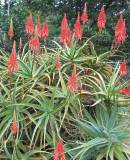
Aloe arborescens Mill.
The krantz aloe is a multi-stemmed, much-branched shrub up to 3 m high (or sometimes even 5 m), with leaves in dense rosettes at the branch tips. Leaves are greyish green with yellow teeth. Inflorescences are usually simple with elongated-inverted conical, densely flowered racemes. It usually grows in pockets of rich soil on rocky outcrops in mountains in areas of high summer rainfall, but can also be found right up to the coast. The krantz aloe is very widely distributed in southeastern Africa from the Cape Peninsula, along the south and east coast of South Africa, as well as further north to Mozambique and the eastern mountains of Zimbabwe and Malawi.
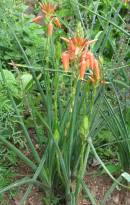
Aloe cooperi Baker
Cooper's grass aloe is characterised by its distichous (2-ranked) leaves that are ridged (keeled or V-shaped) on the lower leaf surface and the inflorescence, which can sometimes be shorter than the leaves, with salmon-pink, green-tipped flowers of 25–40 mm long. It regularly occurs in marshy places, but also grows in well-drained areas, often among rocks on hillsides. This grass aloe occurs mainly in KwaZulu-Natal, Swaziland and Mpumalanga, just entering the eastern Free State and Lesotho.
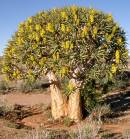
Aloidendron dichotomum (Masson) Klopper & Gideon.F.Sm. (= Aloe dichotoma Masson)
The quiver tree with its very distinctive growth form is a much-branched tree aloe with a thick trunk with peeling bark and a rounded crown. Flowers are bright yellow and borne in short, erect, few-branched inflorescences. It grows in arid, rocky hillsides in the western and northwestern regions receiving minimal rainfall. The quiver tree occurs from the Brandberg in Namibia southwards to Nieuwoudtville, and eastwards to Upington and Kenhardt in South Africa.
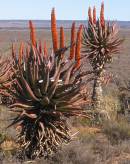
Aloe ferox Mill.
The bitter aloe has an erect, unbranched stem of up to 3 m high, with persistent dried leaves and erect, much-branched, candelabra-like inflorescences with up to eight symmetrical racemes of bright red or orange flowers. It grows on rocky hillsides, on the margins of the karoo, as well as grassy fynbos, Little Karoo and grasslands, where winters may be severe to mild. It is widespread through most of the Eastern Cape and extends into the southeastern Free State, southern Lesotho and the Western Cape to the Swellendam area. The bitter aloe is frequently harvested for use in the medicinal and cosmetics industries.
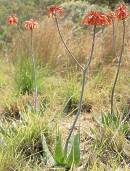
Aloe maculata All.
The common soap aloe is characterised by its spotted, broadly triangular leaves and flat-topped, head-shaped (capitate) racemes reaching 10–12 cm in length and 12–16 cm in diameter with pink or orange, sometime yellow or red, flowers of 35–45 mm in length. It grows in a variety of habitats, including grassland, thicket and rocky outcrops, and is one of the most widely distributed of the spotted or maculate aloes. It occurs from the Cape Peninsula through the Western and Eastern Cape, into the eastern Free State and Lesotho, through KwaZulu-Natal to Mpumalanga and Swaziland.
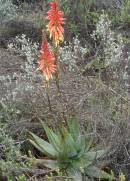
Aloe microstigma Salm-Dyck
The Karoo aloe or Worcester aloe has copiously white-spotted leaves and simple inflorescences of 0.6–0.8 m high, with typically bicoloured racemes. Floral buds are usually a dull red and open flowers greenish yellow and 25–30 mm long. This speckled aloe grows in rocky outcrops in Karoo, desert, semi desert and Namaqua Broken Veld. It has a disjunct distribution, occurring fairly widespread in the western parts of the Eastern Cape, the central areas of the Western Cape and into the Northern Cape, as well as in southwestern Namibia.
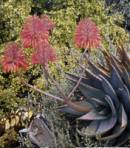
Aloe perfoliata L. (= A. mitriformis Mill.)
The mitre aloe has long, creeping stems with only the terminal apical rosettes erect. Leaves are slightly incurved with variably coloured marginal teeth. The dull to bright red flowers are carried in characteristically rounded or head-shaped (capitate) racemes. This creeping aloe grows in sand and clay and prefers rocky areas, even growing on vertical cliffs. It occurs from the Bokkeveld Mountains near Nieuwoudtville in the Northern Cape, southward to Genadendal in the Western Cape.
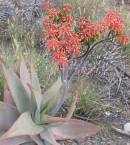
Aloe striata Haw.
The coral aloe is an acaulescent plant, usually with solitary rosettes. Its leaves are sea-green and characteristically striated with narrow, entire (without teeth), pink margins. Inflorescences are much-branched, flat-topped panicles with peach-red to coral-red flowers. It grows in a variety of habitats and is widely distributed from east London through the central and western parts of the Eastern Cape to near De Doorns in the Western Cape.
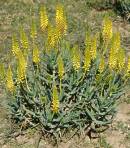
Aloiampelos tenuior (Haw.) Klopper & Gideon F.Sm. (= Aloe tenuior Haw.)
This rambling aloe forms a small untidy shrub consisting of a tangled mass of thin, branched stems. Leaves are blue-green with a prominent sheath that is not auriculate, and obscurely lined. The small red, orange or yellow flowers are cylindric and uncurved, and carried in elongated racemes. This aloe grows in open country on sandy soil and rarely in valley bushveld. It occurs from fairly widely in the Eastern Cape and into southern KwaZulu-Natal, with a disjunct distribution in northern KwaZulu-Natal at the border with Swaziland and Mpumalanga. It is very popular in horticulture.
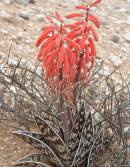
Aloe variegata L.
The partridge-breast aloe is a dwarf aloe that is easily distinguished by its distinctly mottled, dark green to almost black-green, 3-ranked leaves with a creamy white, bony, spineless margins. It grows in clayey soils or rarely soils of decomposed granite, in Karoo vegetation and on the edge of the Namib Desert, usually in the protection of small bushes. It is very widespread, occurring from southern Namibia, through the Northern Cape, eastern parts of the Western Cape and western parts of the Eastern Cape, and just entering the western Free State.
Plant Attributes:
Plant Type:
SA Distribution:
Soil type:
Flowering season:
PH:
Flower colour:
Aspect:
Gardening skill:
Special Features:
Horticultural zones






Rate this article
Article well written and informative
Rate this plant
Is this an interesting plant?
Login to add your Comment
Back to topNot registered yet? Click here to register.